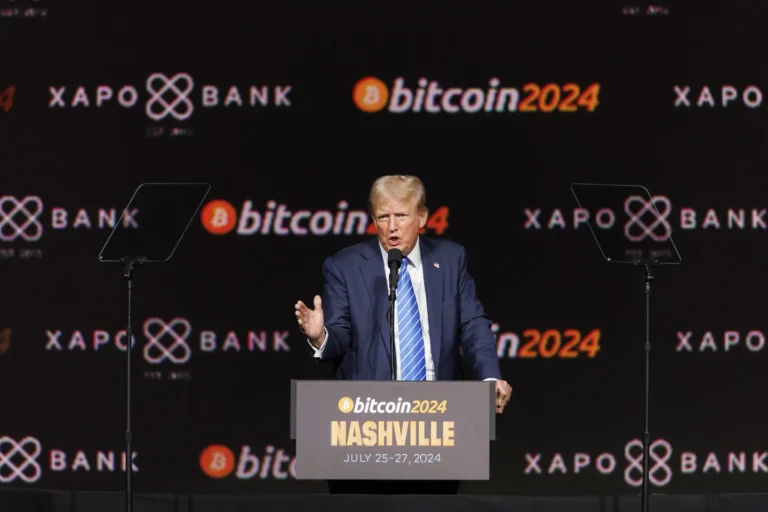Hardy News Cryptocurrency
Hardy News provides in-depth coverage of the latest trends in technology and innovation, focusing on advancements in Artificial Intelligence, machine learning breakthroughs, practical applications, and discussions on ethics in the digital era.

Our Top Picks
Altcoin 시즌 업데이트: Cardano와 Solana의 다음 단계 살펴보기
steve smith 11 months ago
The cryptocurrency market is as dynamic as ever, with Bitcoin often stealing the spotlight. However, altcoins like Cardano (ADA) and...
오늘날 암호화폐에서는 무슨 일이 일어났나요? 트럼프가 암호화폐를 붕괴시킬 수도 있나요?
비트코인, 다시 10만 달러 테스트: 암호화폐의 미래에 어떤 의미가 있나요?
2025년까지 이더리움이 솔라나를 능가할 것: Bitwise CIO, 레이어 2 성장 강조
Latest Guide
비트코인, 다시 10만 달러 테스트: 암호화폐의 미래에 어떤 의미가 있나요?
Bitcoin has made headlines once again as it tests the coveted $100,000 mark. The world’s first cryptocurrency, which has long been a symbol of both volatility and potential, continues to captivate the financial world. For many investors, the question on everyone’s mind is: Will Bitcoin finally break through the $100K barrier, and what will this mean for the future of digital currencies? The Rise of Bitcoin to $100K Bitcoin has seen a remarkable journey since its inception in 2009. Over the years, it has faced numerous challenges, from regulatory scrutiny to market corrections, but its underlying technology—blockchain—has continued to prove its potential. As of late 2024, Bitcoin has experienced a strong surge in value, testing the $100,000 price point once again. This climb is not without reason. Several factors are contributing to Bitcoin’s upward momentum, including institutional adoption, growing acceptance in mainstream finance, and increasing interest from retail investors. The integration of Bitcoin into financial portfolios as a hedge against inflation and economic uncertainty has driven its demand, further fueling its price rise. Institutional Adoption and Mainstream Acceptance One of the key drivers behind Bitcoin’s push towards $100K is the increasing institutional adoption. Major financial institutions, such as banks and hedge funds, are now treating Bitcoin as a legitimate asset class. Many have even added it to their balance sheets, viewing it as a store of value akin to gold. This institutional validation has sparked a wave of confidence in the market, helping to propel Bitcoin toward new heights. Additionally, Bitcoin is gradually being integrated into traditional financial systems. With the emergence of Bitcoin ETFs, futures contracts, and payment platforms like PayPal accepting Bitcoin, the cryptocurrency is becoming more accessible to the average investor. This mainstream acceptance has helped mitigate some of the volatility that has traditionally been associated with Bitcoin, making it a more attractive investment option. The Role of Inflation and Economic Uncertainty Another contributing factor to Bitcoin’s rise is the ongoing economic uncertainty around the world. Central banks around the globe have been printing money at unprecedented rates to combat inflation, leading many to look for alternative stores of value. Bitcoin, with its fixed supply of 21 million coins, is often seen as a hedge against inflation, providing a sense of security in uncertain times. As inflation continues to erode the value of fiat currencies, Bitcoin’s limited supply and decentralized nature make it an appealing option for those seeking protection from inflationary pressures. This has led to increased demand from both institutional investors and individual buyers, further driving its price upwards. The Road Ahead: Will Bitcoin Hit $100K? While Bitcoin’s recent surge is undoubtedly impressive, the road to $100,000 is not without its hurdles. The cryptocurrency market is notoriously volatile, and Bitcoin’s price can fluctuate rapidly in response to news, regulatory changes, and shifts in market sentiment. However, the growing institutional involvement and acceptance of Bitcoin as a legitimate asset class provide a strong foundation for its future growth. Experts remain divided on whether Bitcoin will reach and sustain the $100K level. Some believe that Bitcoin’s price could surpass $100K in the near future, driven by continued demand and adoption. Others caution that regulatory hurdles and market corrections could create obstacles for Bitcoin’s climb to $100K. The Impact on the Broader Crypto Market Bitcoin’s rise to $100,000 would not only be a significant milestone for the cryptocurrency itself but could also have a ripple effect on the broader crypto market. As the largest and most well-known cryptocurrency, Bitcoin often leads the way for other digital assets. A surge in Bitcoin’s price could result in increased attention on other cryptocurrencies, such as Ethereum, Binance Coin, and even smaller altcoins. Moreover, the success of Bitcoin could attract more developers and innovators to the blockchain space, leading to the creation of new decentralized applications (dApps), financial services, and use cases for blockchain technology. The broader adoption of blockchain could lead to greater integration of cryptocurrency into the global economy, further solidifying its position as an alternative asset class. Conclusion Bitcoin testing $100K again is a testament to its resilience and growing acceptance in the financial world. While its path to $100,000 may face challenges, its underlying technology and use cases continue to gain traction. As institutional investors, mainstream platforms, and retail buyers continue to embrace Bitcoin, the future of the cryptocurrency market looks promising. Whether or not Bitcoin hits the $100K mark in the immediate future remains to be seen, but one thing is clear: Bitcoin’s journey is far from over. For investors, this could be the beginning of a new era for digital assets—one where Bitcoin plays a central role in the global economy.
Latest Posts

Scaramucci family invested over $100M in Trump’s Bitcoin mining firm: Report
Solari Capital, led by AJ Scaramucci, has put more than $100 million into American Bitcoin, the mining firm tied to President Trump’s sons.
Published: 2 hours ago

‘Very wide gap’ between XRP and Solana investor interest: Exec
The crypto market is still “very unsure” about which crypto assets to back beyond Bitcoin and Ethereum, according to an executive.
Published: 5 hours ago

Crypto index ETFs will be the next wave of adoption — WisdomTree exec
WisdomTree’s Will Peck said that crypto index ETFs will solve the need for those who don’t want to take on “idiosyncratic risk.”
Published: 8 hours ago

Here’s what happened in crypto today
Need to know what happened in crypto today? Here is the latest news on daily trends and events impacting Bitcoin price, blockchain, DeFi, NFTs, Web3 and crypto regulation.
Published: 11 hours ago

Pro-Bitcoin restaurant Steak 'n Shake announces El Salvador expansion
Steak 'n Shake, an American fast food restaurant company, first began accepting BTC in May and is now expanding its stores to El Salvador.
Published: 11 hours ago

Crypto's long-term fundamentals strong despite market rout — Bitwise CEO
Bitwise CEO Hunter Horsley took a contrarian view to the prevailing crypto investor sentiment, which dropped to a six-month low on Saturday.
Published: 13 hours ago

Crypto treasuries and blockchain are paving the way for decentralized science
Crypto treasury companies and blockchain technology are creating alternative pathways to fund early-stage scientific and medical research.
Published: 15 hours ago

What happens to Satoshi’s 1M Bitcoin if quantum computers go live?
Explore how Satoshi’s untouched 1 million BTC could become crypto’s biggest quantum target, and what a real quantum breakthrough means for early wallets.
Published: 20 hours ago

Aster says tokenomics unchanged amid community confusion after CMC update
Aster says its tokenomics remain unchanged after a CMC update sparked confusion over delayed unlocks, confirming unused tokens will move to a public wallet.
Published: 21 hours ago

Robert Kiyosaki says cash crunch driving crash, stays bullish on Bitcoin, gold
Robert Kiyosaki argues a global cash shortage is driving the market crash and says he’s holding Bitcoin and gold, adding he’ll buy more BTC once the downturn ends.
Published: 23 hours ago

ARK Invest resumes crypto buying spree, adds BitMine and Bullish shares
ARK Invest boosted its crypto-linked holdings, buying $5.8 million in BitMine and $2.9 million in Bullish shares amid market dip.
Published: 1 day ago

Crypto sentiment index sinks to lowest score since February
Although the crypto sentiment index hasn’t fallen this low in more than eight months, some analysts argue the situation isn’t as dire as it appears.
Published: 1 day ago

Crypto bottoms ‘rarely occur’ when everyone says they do: Santiment
Crypto sentiment platform Santiment warned that when many people start calling a crypto market bottom, it’s wise to stay skeptical.
Published: 1 day ago

Crypto oversight by CFTC over SEC is ‘directionally correct’ — Jeff Park
Jeff Park’s pro-CFTC comments come just days after US senators introduced a bill pushing to shift crypto oversight from the SEC to the CFTC.
Published: 1 day ago

Bitcoin hits 6-month low as AI fears add to risk-off mood: How are pro traders positioned?
The weakness in the AI sector contributed to the crypto market downturn, as spot BTC ETF outflows and isolated selling sent Bitcoin price to a six-month low.
Published: 1 day ago

SOL drops to 5-month low despite Solana spot ETF success: Is $100 next?
Solana ETFs recorded inflows for 13 consecutive days, but SOL price lost key technical support levels, sparking fears of a drop to $100.
Published: 1 day ago

Probability of December interest rate cut falls below 50%
Nearly 67% of investors forecast an interest rate cut of 25 basis points in December when polled during the first week of November.
Published: 1 day ago

BitMine appoints new CEO amid Ether buying spree
BitMine held about $11 billion worth of ETH as of this week, making it the largest Ether treasury in the cryptocurrency industry.
Published: 1 day ago

Bitcoin miners retreat sharply as BTC pulls back from recent highs
Major mining stocks dropped 20%–50% this week, erasing billions in value as the sector continued to lag Bitcoin’s latest pullback.
Published: 2 days ago

Bitcoin's 2-year trend is about to collapse: Will bulls defend $90K?
Bitcoin lost multiple critical support areas as data show short-term investors holding on to capitulation-level losses, raising fears of a deeper breakdown in BTC price.
Published: 2 days ago

Binance adds BlackRock’s BUIDL as off-exchange collateral for institutional traders
The integration marks another step in centralized exchanges adopting tokenized Treasurys, expanding RWA collateral across major trading platforms.
Published: 2 days ago

Latest BTC market dip is relatively small, but sentiment is in freefall
Bitcoin has seen bigger crashes during the current cycle, but investor sentiment is hovering near lows not seen since March.
Published: 2 days ago

Strategy’s NAV falls under 1, critics raise alarm after $5.7B Bitcoin wallet move
Strategy moves $5.7 billion in Bitcoin as its net asset value to its Bitcoin holdings drops below one for the first time, sparking valuation concerns amid marketwide speculation.
Published: 2 days ago

‘Volatility is your friend’: Eric Trump not bothered by Bitcoin, crypto carnage
Eric Trump shrugs off an extended crypto sell-off as American Bitcoin ramps up its holdings and climbs into the top ranks of public BTC treasuries.
Published: 2 days ago

Price predictions 11/14: BTC, ETH, XRP, BNB, SOL, DOGE, ADA, HYPE, LINK, BCH
Bitcoin has broken below the psychologically crucial $100,000 level, signaling that the bears are in full control. The next strong support on the downside is at $87,800.
Published: 2 days ago

Bitcoin falls to 6-month low as ETF demand collapses: Finance Redefined
Bitcoin drops to a six-month low as spot ETF outflows resume despite the US shutdown ending, signaling weak demand and renewed pressure on crypto markets.
Published: 2 days ago

Real estate hybrid funds challenge DATs with mix of property and Bitcoin
Most crypto treasury companies today lack an operational business that generates cash flow to finance additional digital asset purchases.
Published: 2 days ago

ETH long-term holders dump 45K Ether per day: Is a price drop to $2.5K next?
Ether price is at risk of a 23% drop to $2,500 if long-term investors maintain their current pace of selling. Cointelegraph explains what must happen for a bullish reversal to take place.
Published: 2 days ago

‘We are buying’: Michael Saylor denies reports of Strategy dumping BTC
Strategy will add to its 640,000 Bitcoin holdings by continuing to buy amid a flash crash in BTC price, Michael Saylor said.
Published: 2 days ago

Tether to accelerate push into commodity lending with cash, USDt credit
Tether is expanding its commodity-trade lending after deploying $1.5 billion in credit, marking a deeper shift from stablecoin issuer to global finance player.
Published: 2 days ago


























